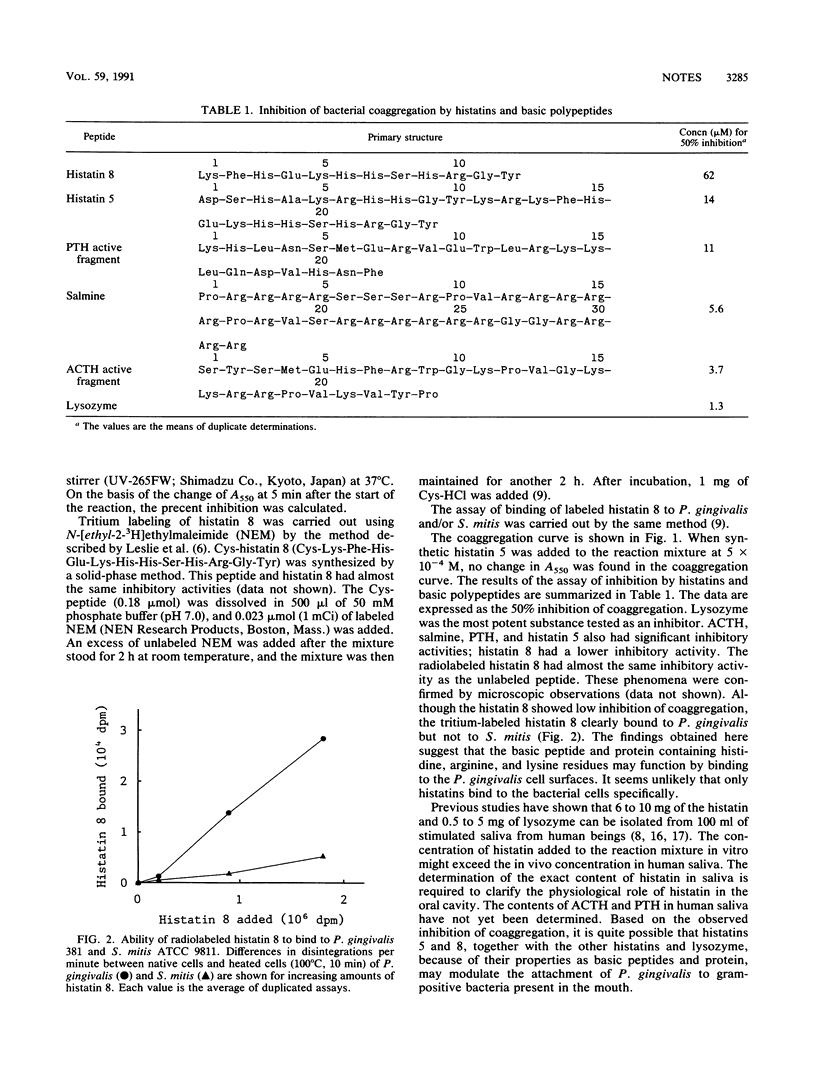Abstract
The effects of histatins on coaggregation between Porphyromonas gingivalis 381 and Streptococcus mitis ATCC 9811 were investigated by using a turbidimetric assay. The coaggregation activity was significantly inhibited by histatins 5 and 8 and strongly by lysozyme. Tritium-labeled histatin 8 bound to P. gingivalis cells but not to S. mitis cells.
Full text
PDF


Selected References
These references are in PubMed. This may not be the complete list of references from this article.
- Baum B. J., Bird J. L., Millar D. B., Longton R. W. Studies on histidine-rich polypeptides from human parotid saliva. Arch Biochem Biophys. 1976 Dec;177(2):427–436. doi: 10.1016/0003-9861(76)90455-0. [DOI] [PubMed] [Google Scholar]
- Boyd J., McBride B. C. Fractionation of hemagglutinating and bacterial binding adhesins of Bacteroides gingivalis. Infect Immun. 1984 Aug;45(2):403–409. doi: 10.1128/iai.45.2.403-409.1984. [DOI] [PMC free article] [PubMed] [Google Scholar]
- Gibbons R. J., Etherden I. Comparative hydrophobicities of oral bacteria and their adherence to salivary pellicles. Infect Immun. 1983 Sep;41(3):1190–1196. doi: 10.1128/iai.41.3.1190-1196.1983. [DOI] [PMC free article] [PubMed] [Google Scholar]
- Hay D. I. Fractionation of human parotid salivary proteins and the isolation of an histidine-rich acidic peptide which shows high affinity for hydroxyapatite surfaces. Arch Oral Biol. 1975 Sep;20(9):553–558. doi: 10.1016/0003-9969(75)90073-4. [DOI] [PubMed] [Google Scholar]
- Inoshita E., Amano A., Hanioka T., Tamagawa H., Shizukuishi S., Tsunemitsu A. Isolation and some properties of exohemagglutinin from the culture medium of Bacteroides gingivalis 381. Infect Immun. 1986 May;52(2):421–427. doi: 10.1128/iai.52.2.421-427.1986. [DOI] [PMC free article] [PubMed] [Google Scholar]
- LESLIE J., WILLIAMS D. L., GORIN G. Determination of mercapto groups in proteins with N-ethylmaleimide. Anal Biochem. 1962 Mar;3:257–263. doi: 10.1016/0003-2697(62)90062-3. [DOI] [PubMed] [Google Scholar]
- MacKay B. J., Denepitiya L., Iacono V. J., Krost S. B., Pollock J. J. Growth-inhibitory and bactericidal effects of human parotid salivary histidine-rich polypeptides on Streptococcus mutans. Infect Immun. 1984 Jun;44(3):695–701. doi: 10.1128/iai.44.3.695-701.1984. [DOI] [PMC free article] [PubMed] [Google Scholar]
- MacKay B. J., Pollock J. J., Iacono V. J., Baum B. J. Isolation of milligram quantities of a group of histidine-rich polypeptides from human parotid saliva. Infect Immun. 1984 Jun;44(3):688–694. doi: 10.1128/iai.44.3.688-694.1984. [DOI] [PMC free article] [PubMed] [Google Scholar]
- Murakami Y., Amano A., Takagaki M., Shizukuishi S., Tsunemitsu A., Aimoto S. Purification and characterization from human parotid secretion of a peptide which inhibits hemagglutination of Bacteroides gingivalis 381. FEMS Microbiol Lett. 1990 Nov;60(3):275–279. doi: 10.1016/0378-1097(90)90316-i. [DOI] [PubMed] [Google Scholar]
- Murakami Y., Takeshita T., Shizukuishi S., Tsunemitsu A., Aimoto S. Inhibitory effects of synthetic histidine-rich peptides on haemagglutination by Bacteroides gingivalis 381. Arch Oral Biol. 1990;35(9):775–777. doi: 10.1016/0003-9969(90)90103-h. [DOI] [PubMed] [Google Scholar]
- Nagata H., Murakami Y., Inoshita E., Shizukuishi S., Tsunemitsu A. Inhibitory effect of human plasma and saliva on co-aggregation between Bacteroides gingivalis and Streptococcus mitis. J Dent Res. 1990 Aug;69(8):1476–1479. doi: 10.1177/00220345900690080501. [DOI] [PubMed] [Google Scholar]
- Oppenheim F. G., Xu T., McMillian F. M., Levitz S. M., Diamond R. D., Offner G. D., Troxler R. F. Histatins, a novel family of histidine-rich proteins in human parotid secretion. Isolation, characterization, primary structure, and fungistatic effects on Candida albicans. J Biol Chem. 1988 Jun 5;263(16):7472–7477. [PubMed] [Google Scholar]
- Pollock J. J., Denepitiya L., MacKay B. J., Iacono V. J. Fungistatic and fungicidal activity of human parotid salivary histidine-rich polypeptides on Candida albicans. Infect Immun. 1984 Jun;44(3):702–707. doi: 10.1128/iai.44.3.702-707.1984. [DOI] [PMC free article] [PubMed] [Google Scholar]
- Slots J., Gibbons R. J. Attachment of Bacteroides melaninogenicus subsp. asaccharolyticus to oral surfaces and its possible role in colonization of the mouth and of periodontal pockets. Infect Immun. 1978 Jan;19(1):254–264. doi: 10.1128/iai.19.1.254-264.1978. [DOI] [PMC free article] [PubMed] [Google Scholar]
- Sugiyama K., Ogino T., Ogata K. Rapid purification and characterization of histatins (histidine-rich polypeptides) from human whole saliva. Arch Oral Biol. 1990;35(6):415–419. doi: 10.1016/0003-9969(90)90202-l. [DOI] [PubMed] [Google Scholar]


